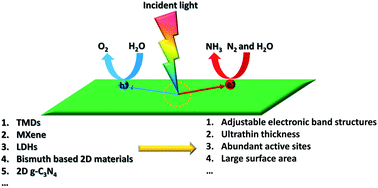Two-dimensional building blocks for photocatalytic ammonia production
Abstract
Owing to its extensive utilization in fertilizer generation and as an energy carrier, ammonia (NH3) is deemed to be one of the most essential chemicals. Currently, NH3 generation mostly depends on the Haber–Bosch approach under harsh conditions, resulting in tremendous energy usage and environmental problems. Photocatalytic NH3 generation represents a clean, inexpensive and environmentally friendly method to transform water and nitrogen into ammonia utilizing sunlight under ambient conditions. Recently, two-dimensional (2D) building blocks have received great attention in the photocatalysis field thanks to their outstanding features of high surface area, plentiful reactive sites, ultrathin thickness and short charge-to-surface transfer distance. This perspective summarizes the design and synthesis of photocatalysts prepared utilizing 2D building blocks towards light-driven NH3 production. Our contribution highlights the in-depth and comprehensive structure/composition–performance relationship in 2D building block based photocatalysts for light-induced NH3 production. We also discuss the delicate and insightful reaction mechanisms in 2D building block based photocatalytic NH3 production. Finally, we propose the possible opportunities in merging advanced characterization techniques as well as powerful theoretical computations towards the rational design and fabrication of high-performance 2D material based photocatalysts towards light-induced NH3 generation.

- This article is part of the themed collection: Journal of Materials Chemistry A Emerging Investigators


 Please wait while we load your content...
Please wait while we load your content...